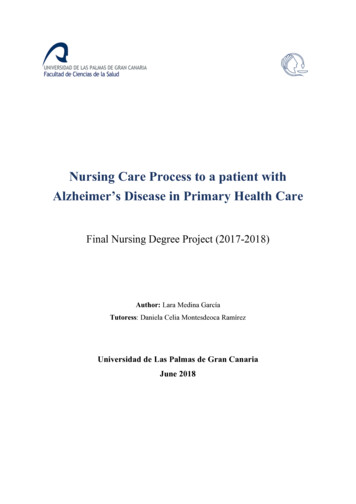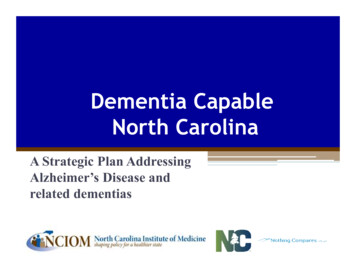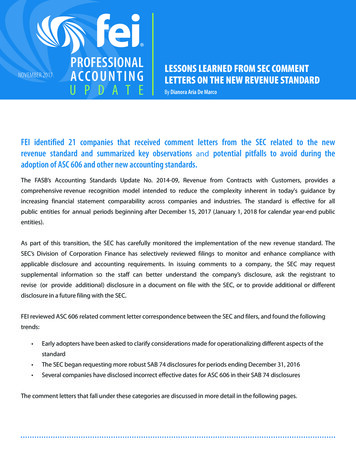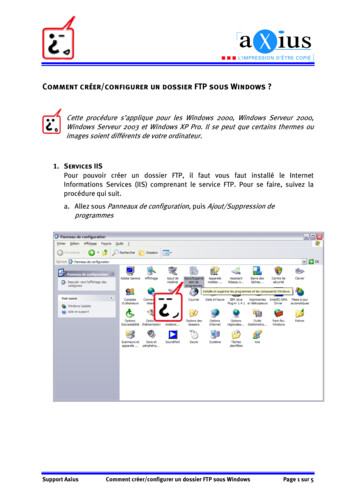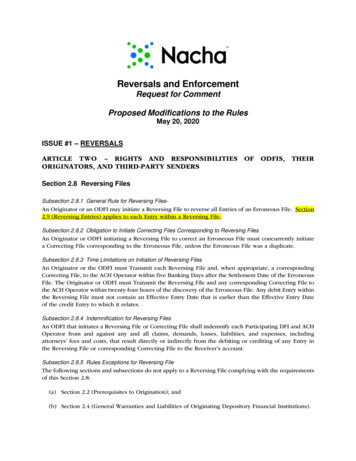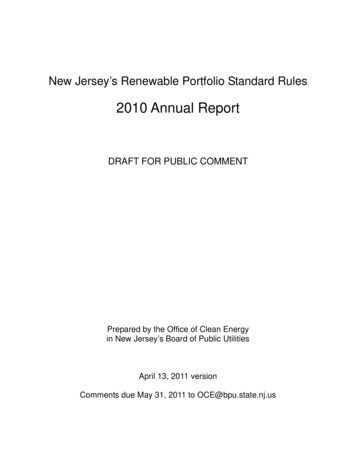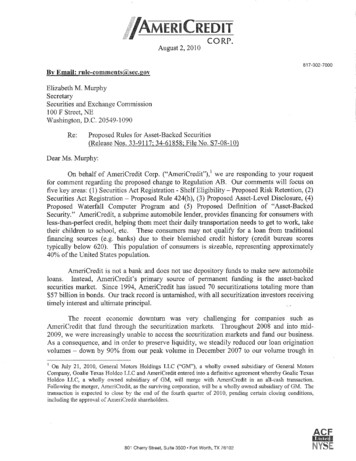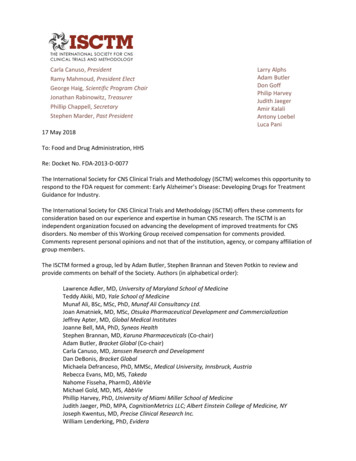
Transcription
Carla Canuso, PresidentRamy Mahmoud, President ElectGeorge Haig, Scientific Program ChairJonathan Rabinowitz, TreasurerPhillip Chappell, SecretaryStephen Marder, Past PresidentLarry AlphsAdam ButlerDon GoffPhilip HarveyJudith JaegerAmir KalaliAntony LoebelLuca Pani17 May 2018To: Food and Drug Administration, HHSRe: Docket No. FDA-2013-D-0077The International Society for CNS Clinical Trials and Methodology (ISCTM) welcomes this opportunity torespond to the FDA request for comment: Early Alzheimer’s Disease: Developing Drugs for TreatmentGuidance for Industry.The International Society for CNS Clinical Trials and Methodology (ISCTM) offers these comments forconsideration based on our experience and expertise in human CNS research. The ISCTM is anindependent organization focused on advancing the development of improved treatments for CNSdisorders. No member of this Working Group received compensation for comments provided.Comments represent personal opinions and not that of the institution, agency, or company affiliation ofgroup members.The ISCTM formed a group, led by Adam Butler, Stephen Brannan and Steven Potkin to review andprovide comments on behalf of the Society. Authors (in alphabetical order):Lawrence Adler, MD, University of Maryland School of MedicineTeddy Akiki, MD, Yale School of MedicineMunaf Ali, BSc, MSc, PhD, Munaf Ali Consultancy Ltd.Joan Amatniek, MD, MSc, Otsuka Pharmaceutical Development and CommercializationJeffrey Apter, MD, Global Medical InstitutesJoanne Bell, MA, PhD, Syneos HealthStephen Brannan, MD, Karuna Pharmaceuticals (Co-chair)Adam Butler, Bracket Global (Co-chair)Carla Canuso, MD, Janssen Research and DevelopmentDan DeBonis, Bracket GlobalMichaela Defranceso, PhD, MMSc, Medical University, Innsbruck, AustriaRebecca Evans, MD, MS, TakedaNahome Fisseha, PharmD, AbbVieMichael Gold, MD, MS, AbbViePhillip Harvey, PhD, University of Miami Miller School of MedicineJudith Jaeger, PhD, MPA, CognitionMetrics LLC; Albert Einstein College of Medicine, NYJoseph Kwentus, MD, Precise Clinical Research Inc.William Lenderking, PhD, Evidera
Jeffery Lieberman, MD, Columbia UniversityAntony Loebel, MD, Sunovion Pharmaceuticals Inc.Hans Moebius, MD, PhD, Moebius-Consult GmbHJonathan Norton, PhD, Takeda Pharmaceuticals USA Inc.Cedric O’Gorman, MD, MBA, Axsome Therapeutics Inc.Holly Posner, MD, MS, Pfizer Inc.Steven Potkin, MD, University of California, Irvine (Co-chair)Jill Rasmussen, MD, psi-napseMichael Ropacki, PhD, Strategic Global Research and DevelopmentGary Sachs, MD, Bracket GlobalStephen Sainati, MD, PhD, Aptinyx Inc.Martha Sajatovic, MD, Case Western Reserve University School of MedicineAndrew Satlin, MD, Intra-Cellular TherapiesPeter Schueler, MD, ICON Clinical Research Inc.Joanna Segieth, PhD, UCBYingqi Shi, PhD, Janssen Research and DevelopmentThomas Shiovitz, MD, California Neuroscience Research Medical Group Inc.Oleg Tcheremissine, MD, Carolina HealthCare SystemGary Tong, MD, PhD, LundbeckSilvia Zaragoza Domingo, PhD, LundbeckJun Zhao, PhD, AbbVieCOMMENTS ON THE EARLY ALZHEIMER’S DISEASE: DEVELOPING DRUGS FOR TREATMENT GUIDANCEFOR INDUSTRY:General CommentsISCTM welcomes this guidance, and is encouraged that the FDA has provided a number of new areas fordrug developers and researchers to consider related to new treatment development for Alzheimer’sDisease. Expanding on previous guidance related to diagnosis, clinical outcome measures, andbiomarkers, will be useful in the design of future programs. We feel that this document provides areasonable amount of discretion around many areas that are changing rapidly, such as which scales andbiomarkers may be appropriate in certain situations, without narrowing options for those who arepursuing novel approaches.II. BackgroundThis document uses the terms “clinically meaningful” and “clinical meaningfulness” in several areas.While clinically meaningful is generally defined well by the FDA, it may be helpful to expand on how theagency views “clinically meaningful” in the context of the proposed stages for AD as this may providefurther clarity on meaningfulness.Beginning on line 69: this paragraph could be clarified. The paragraph states first that cognition “is mostcertainly meaningful in terms of daily function.” The sentences that follow state, “more markedcognitive changes may represent impairment that is clearly clinically meaningful.” However, this raisesan ‘issue of concern’ around how these cognitive deficits are measured and appears somewhatinconsistent with earlier statements by indicating, “cognition is meaningful, but when measured usingconventional approaches with sensitive tools directed at particular domains, the meaningfulness ofmeasured changes may not be apparent.” Additional clarification would be helpful as episodic memorydeficits are the core concern of Alzheimer’s disease patients early on in the disease course, and arereadily measured by many sensitive neuropsychological tests.
In general, this document appears to leave more flexibility for developers and researchers to identifybiomarkers that may be useful for an individual study or compound. Expanding on what criteria wouldbe used for biomarker evaluation specific to Alzheimer’s disease could be useful.III. Diagnostic CriteriaRegarding line 111, how can we show that entry criteria for a study “reliably define a population withearly AD”, particularly before the study has completed?IV. Outcome MeasuresIt is welcomed that the agency is proactively sharing its thinking regarding different stages of the ADcontinuum and attempting to pair them with appropriate outcome measures. The ISCTM agrees thatdifferent outcome measures will be appropriate for different stages of the continuum. A somewhatminor structural consideration that might help decrease confusion would be to not present the stages inthe reverse order of the previous section, as well as a brief statement that “Stage 4” does not representearlier stages and thus seems adequately covered by previous guidance and precedent regardingoutcome measures and requires no further discussion. ISCTM recognizes that the staging closely followsthat which was recently published from the NIA-AA Research Framework.Stage 3The (continued) proposal of a single primary endpoint for approval again brings up the discussion of anintegrated scale in 171-173. Likewise, on the following page (5, 175-177) the guidance providesadditional clarification of what this scale may look like. However, the draft guidance would be morehelpful if the agency were willing to provide the category(s) that this type of hypothetical measure fallsinto [e.g., Performance Outcome Measure], as the guidance appears to imply this would be aperformance-based functional measure. That is, a neuropsychological test that measures a cognitivedomain and function, but that is also clinically meaningful at the patient level (e.g., an episodic memorylist learning task consisting of medication instructions), might be acceptable. Inclusion of this additionalgranularity would be welcomed and most helpful to those designing and running interventional clinicaltrials.An example of cognition and functionality may be demonstrated in the Financial Capacity Instrument short form (FCI-SF, Marson et al.) Authors note that functional change in subtle financial skills decline inpreclinical stage (as early as stage 1), is reflected in slower task completion times (a cognitive measure)and is related to biomarker status (e.g. amyloid PET).However, the assertion/implication that an improvement in cognition using neuropsychological tests isnot by itself a meaningful index of a drug's functional benefit (167, 179-181) does not seem to recognizerecent (and not so recent) developments in the field. There are papers which appear to quantify deficitsin neuropsychological tests that are associated with known functional benchmarks; for example,intoxication with a range of agents, (Cook et al., 2005; Thapar, Zacny, Thompson, & Apfelbaum, 1995),(Ginani et al., 2011; Pompeia, Pradella-Hallinan, Manzano, & Bueno, 2008; Roth, Roehrs, Koshorek,Sicklesteel, & Zorick, 1987), (M.J. Mattila & Patat, 1996; M.J. Mattila, Vanakoski, Kalska, & Seppala,1997),sleep deprivation (Tucker, Whitney, Belenky, Hinson, & Van Dongen, 2010), as well as thebenefits of caffeine intake (Kassis, Katz, Ravid, & Pillar, 2013; Lane, 1997). Thus, it appears thatcorrelation to function may not be as uncertain as the guidance claims. As the guidance appears toacknowledge (175-177), currently there are no adequate functional outcome measures for this stage(which by earlier definitions had no functional deficit). Thus, current tools for measuring functional
change in stage 3 patients are less precise, more subjective, and poorly correlated with cognitivemeasures; whereas cognitive measures reflect the hallmark of the disease, correlate with itspathophysiology, and measure functions that patients and caregivers almost uniformly regard asmeaningful. (Ropacki, Hannesdottir and Hendrix, 2017). ISCTM would suggest that the FDA allow themore recent, updated conceptualizations and findings in this area to be incorporated rather than solelyhope for rapid development of new outcome measures that may not be ready for some time (andapparently will be redefining functionality to acknowledge new levels of subtle impairment). Weacknowledge that the FDA appears to be more open to this possibility for “Stage 2 Patients”.Stage 2We agree with the FDA that for the defined Stage 2 patients, “with only subtle cognitive deficits”detectable (187-188) that it is currently very difficult to envision how to establish a clinically meaningfuleffect for differences in cognitive (or functional) outcomes in trials of “reasonable duration”.The discussion regarding how the convergence of neuropsychological test findings (199-202) or “a largemagnitude of effects on sensitive measures of neuropsychological performance” may be helpful tomaking a compelling case to the agency could be more useful if augmented with some examples ofwhat constitutes subtle detectable abnormalities either at the individual level (e.g., amount of deviationfrom age- and education-corrected norms) or group level (e.g., trend or statistical significance levelrequired). Similarly, though it was not explicitly stated here, changes in biomarkers of ADpathophysiology would be judged similarly. ISCTM notes that this stance is not dissimilar to other datathat the FDA monitors and it may be helpful to explicitly state this.It also appears that studies at this stage may need to end up being longer than typical trial duration,leading to the difficult discussion of the certainty of future clinical course and its relationship to thechanges seen (207-211 and later 263-289). These uncertainties currently make it hard to envision howone can currently make a credible argument and we urge the agency to find different terms than“certainty” and “inevitability”, which appear on the surface to be a very high threshold for biologicalsystems.Stage 1From the current definition of Stage 1 Patients, it would appear that the only way to show an effect isthrough biomarker changes. ISCTM appreciates the agency’s willingness to consider such an approach aswell as its assessment that the current understanding of biomarker progression is not yet fullyestablished regarding the uncertainties mentioned in the previous section and that precompetitivecollaboration may be needed to evolve our understanding of the various biomarkers that might beassociated with the Alzheimer’s continuum. ISCTM feels that the standard mentioned of (line 231)“reasonably likely to predict clinical benefit” is appropriate both here and in the previous section.Further clarification regarding thinking about “post approval requirements” for full approval if this firststep is successful would be helpful.BiomarkersNIH working group defined biomarker as “a characteristic that is objectively measured and evaluated asan indicator of normal biological processes, pathogenic processes, or pharmacologic responses to anintervention” (BDWG, 2001). Biomarkers can be used to aid in diagnosis, to staging an illness, to predictdiagnostic conversion or to predict and monitor clinical response to treatment (FDA, 2014). It may bemore productive to identify subgroups of individuals who share biological patterns in common that maypredict preferential response to targeted treatments. In order to guide treatment, biomarkers should
reflect disease mechanisms that are relevant to the selection of therapeutic options. If measured earlyenough, biomarkers for these factors might identify individuals at risk in order to modify or haltprogression of the aberrant process.The FDA’s guidance on Drug Development Tools (DDT; Qualification Process for Drug Development Tools(FDA, 2014)) identifies two separate processes necessary to develop novel biomarkers for drugdevelopment. The first step is analytical validation of assays and the second step defines how thebiomarker should be used in the context of clinical management or drug development and includes thebiomarker's purpose, its boundaries, the conditions of qualified use, and its interpretation. In the clinicalresearch literature, statistically significant differences in mean values of analytes or imaging findingsbetween target populations and controls groups are often interpreted as potential biomarkers.However, the predictive value of a biomarker depends on many factors, including generalizability acrossclinical populations, the reliability of the biomarker, the sensitivity and specificity for the specific targetpopulation and on the relative prevalence of the target population. Due to issues of poor reliability andgeneralizability, many promising biomarkers have failed replication and for those biomarkers that havesuccessfully achieved replication, overlap in values between groups may be great enough to make thebiomarker of little or no clinical value. Very few publications provide the positive predictive value (PPV),i.e., the ratio of the number of true or accurate positive predictions / total number of positive testpredictions (both true and false).Even biomarkers that are not related to drug targets may be useful in enriching a clinical trial sample byremoving unwanted variability.Biomarker RefsBDWG, B.D.W.G., 2001. Biomarkers and surrogate endpoints: preferred definitions andconceptual framework. Clin. Pharmacol. Ther. 69, 89–95.FDA, 2014. Guidance for Industry and FDA Staff- Qualification Process for Drug DevelopmentTools. In: U.S. Department of Health and Human Services, F.a.D.A., Center for Drug Evaluationand Research (CDER) Ed. Silver Spring, MD.Time to Event & Assessment of Disease courseThe discussion of the assessment of disease course is welcomed but could benefit from a discussion onthe agency opinion concerning the use of longitudinal cohort study (LCS) designs (e.g., IMI-EPAD LCS,CHARIOT-PRO) in interventional clinical trials. Previously, Dr. Janet Woodcock had publicly supportedverbally the use of these data as run-in data for an eventual clinical trial as long as the LCS was done toGCP, and these same patients entered the follow-on interventional clinical trial. However, agencyclarification on these statements in writing within the draft guidance would be most helpful for the field.Establishing a bar of “permanence” for the expected effect of a drug on disease course, and that thateffect continue in absence of drug exposure, seems high and inconsistent with other clinicallymeaningful interventions.ReferencesCook, J. A., Lehman, A. F., Drake, R., McFarlane, W. R., Gold, P. B., Leff, H. S., . . . Grey, D. D. (2005).Integration of psychiatric and vocational services: a multisite randomized, controlled trial ofsupported employment. Am. J. Psychiatry, 162(10), 1948-1956.Ginani, G. E., Tufik, S., Bueno, O. F., Pradella-Hallinan, M., Rusted, J., & Pompeia, S. (2011). Acute effectsof donepezil in healthy young adults underline the fractionation of executive functioning. JPsychopharmacol, 25(11), 1508-1516. doi:10.1177/0269881110391832
Kassis, O., Katz, N., Ravid, S., & Pillar, G. (2013). double-Blind Placebo and active (caffeine) controlledstudy to examine the effects of the Herbal nutritional supplement Beverage “wake up ” onvigilance and Function after lunch. Israeli Medical Association Journal, 15, 487-491.Lane, J. D. (1997). Effects of Brief Caffeinated-Beverage Deprivation on Mood, Symptoms, andPsychomotor Performance. Pharm. Biochem. Behav, 58(1), 203-208.Mattila, M. J., & Patat, A. (1996). Single oral doses of amisulperide do not enhance the effects ofalcoholon the performance and memory of healthy subjects. Eur J Clin Pharmacol, 51, 161-166.Mattila, M. J., Vanakoski, J., Kalska, H., & Seppala, T. (1997). Effects of alcohol, zolpidem and some othersedatives and hypnotics on human performance and memory. Pharmacology Biochemistry &Behavior, 59(4), 917-923.Pompeia, S., Pradella-Hallinan, M., Manzano, G. M., & Bueno, O. F. (2008). Effects of lorazepam on visualperceptual abilities. Hum Psychopharmacol, 23(3), 183-192. doi:10.1002/hup.927Roth, T., Roehrs, T., Koshorek, G., Sicklesteel, J., & Zorick, F. (1987). Sedative effects of antihistamines. JAllergy Clin Immunol, 80(1), 94-98.Thapar, P., Zacny, J. P., Thompson, W., & Apfelbaum, J. L. (1995). Using Alcohol as a standard to assessthe degree of impairment induced by sedative and analgesic drugs used in ambulatory surgery.Anaesthesiology, 82(1), 53-59.Tucker, A. M., Whitney, P., Belenky, G., Hinson, J. M., & Van Dongen, H. P. P. (2010). Effects of sleepdeprivation on dissociated components of executive functioning. Sleep, 33(1), 47-57.
Lawrence Adler, MD, University of Maryland School of Medicine Teddy Akiki, MD, . Carla Canuso, MD, Janssen Research and Development Dan DeBonis, Bracket Global Michaela Defranceso, PhD, MMSc, . Jeffery Lieberman, MD, Co

